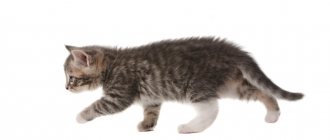Lameness in cats can be caused by a number of reasons. At the same time, a number of them, as a rule, are hidden and cannot be identified without appropriate examination and diagnostic procedures.
So, if a cat is limping, then the first thing the owner should rule out (he can do it himself) is various wounds. You especially need to look carefully between the joints of the limbs, since cases of cuts in these areas are not uncommon. Since these zones are hidden from visual inspection, the cause of lameness may be hidden there.
There are often cases when a cat limps as a result of dislocations and sprains. Especially among those felines who lead a sedentary lifestyle and are overweight. In such cases, the cat will limp quite heavily at first.
The cat is limping
At the same time, in the area of the damaged joint, a local increase in temperature, swelling of the surrounding tissues, and pronounced pain upon tactile influence may be observed.
After some time (several days to a week), lameness may decrease.
The reason when a cat is limping on a front or back leg can be a fracture. In this case, the animal, as a rule, holds the damaged limb in a canopy.
An unnatural position of the joints on the injured limb can often be observed. The paw is hot, swollen, very painful.
In some cases, open fractures may occur, in which bone fragments may be visible in the wounds.
Many cat owners ask the question - why does a cat limp? There are no changes in the appearance of the limbs, and there are also no wounds.
In this case, there is a high probability of salt deposits in the joints.
The reasons for this may be: individual predisposition, unhealthy diet, lack of a nutritious diet and a whole range of other reasons. In this case, lameness occurs quite spontaneously.
Source: https://vetlapa.ru/koshka-hromaet,-chto-delat
Internal diseases
Sometimes the causes of “dragging” of one or two hind legs can be a consequence of internal pathologies.
Physiological fractures
Bone tissue may lose its strength and elasticity. Even slight pressure on a bone can cause it to fracture. The problem occurs due to:
- improperly selected diet;
- lack of vitamins and minerals;
- excess phosphorus, vitamins A and D, fluorine, magnesium;
- renal failure;
- thyroid diseases;
- pathologies of the digestive system;
- breed predisposition.
Siamese, Scottish, British and Sphynx cats suffer from hyperparathyroidism more than others.
Arthritis or arthrosis
Disease of the hip joints can be localized on one side or both. The animal begins to limp gradually. But the characteristic “wiggle” of the rear when moving is becoming more and more noticeable. The problem often occurs in elderly individuals. But the disease can also affect young cats if they have suffered trauma to the pelvic area in the past. Treatment involves significantly slowing the progression of the disease. It is impossible to completely recover from such an illness.
What to do if a kitten has a bruised paw: symptoms, treatment and first aid
Contusion in cats is a common type of mechanical injury. Bruises can affect various parts of the animal's body, including the paws. The result of paw bruises can be pain, limited mobility, disruption of the integrity of blood vessels, and so on.
Bruises occur for various reasons. Cats, and especially active kittens, can injure their paws during a fight with other animals, during a fall or an unsuccessful descent from a certain height, and in other conditions.
Most owners cannot be with their pet all the time. Therefore, there is a possibility that you will miss the moment of getting a bruise on your paw or paws and will only find out about the problem after the cat has limped.
It is important to pay close attention to your pet's behavior so as not to miss warning signs.
- chipping (implantation under the skin)
- teeth cleaning (tartar removal)
- surgery (operations at home and in the clinic)
- Ultrasound (ultrasound examination)
- euthanasia and cremation of animals
- castration (sterilization of animals)
- haircut (haircut at home)
- childbirth (delivery)
- vaccinations (vaccination)
- piroplasmosis (treatment and prevention)
- traumatologists (ostiosynthesis)
- tests (laboratory diagnostics)
- therapy
- x-ray
- ophthalmology
- dermatology
- neurology
- cardiology
It can be difficult to detect manifestations of this type of mechanical tissue damage in cats, such as a bruise, especially if the cat is not limping.
Getting a bruise on the front or back paw is often accompanied by problems with the circulatory system and internal organs in the pet’s body. Mechanical damage caused by a fall or blow with a blunt heavy object often provokes internal hemorrhages.
In turn, in the case of simultaneous external damage to skin tissue, muscles and bones can be exposed to infection.
Degree of paw bruises in a kitten or adult cat
Mechanical damage to the limb such as a bruised paw in cats is divided into four degrees:
11th degree. A characteristic feature of bruises is damage to the inner layers of the skin and subcutaneous tissue. A bruise may be accompanied by the formation of a shallow wound such as an abrasion or scratch.
Swelling of the injury site and pain are likely. The pain is mild and may be completely absent. Upon examination, you can notice signs of burst blood vessels on the surface of the animal’s skin. A first degree bruise is characterized by rapid healing and does not require complex treatment. Often, with a first-degree bruise, the cat does not limp. 22nd degree. Bruises of this type are accompanied by the formation of hematomas, separation and rupture of muscles. A common sign of injury is swelling caused by the inflammatory process.
The animal has an elevated temperature, increased heart rate and breathing, and the cat limps for a long time. 33rd degree. Such bruises pose a real threat not only to the health, but also to the life of the cat. Third degree damage is accompanied by a change in the appearance of the skin. The concept of bruise in this case means damage to muscle tissue, tendons, the formation of fractures and cracks in bones.
Along with a 3rd degree bruise, joint dislocation is often noted. When bruised, the animal experiences shock.
In the absence of qualified assistance during the first day from the moment of injury, there is a risk of developing tissue necrosis. 44 degree. Mechanical damage to the limbs of the 4th degree is the most dangerous for a cat. Injuries of this complexity are accompanied by crushing of bones and crushing of tissues. Through external damage to the skin, infection enters the animal’s body. Thus, inflammatory and purulent-putrefactive processes occur. The consequence of injury is often an abscess, sepsis and associated negative processes.
Do not neglect qualified veterinary care to avoid potentially dangerous consequences.
- Always have your diplomas and all documents with you
- Free consultation with a veterinarian before departure
- More than 20 specialized specialists
- We carry out disinfection of premises before operating rooms
- We create a medical history for each animal
- Complex operations are performed in a hospital
How to detect bruised limbs in cats?
The following symptoms indicate a bruised paw in a cat:
- The appearance of swelling on the animal's paw. Swelling of the injury site is caused by internal bleeding. While the skin remains intact, blood accumulates inside, causing a characteristic swelling.
- Restless behavior of a pet. When a cat receives a mechanical injury, it feels discomfort and its behavior differs from usual. The pet looks for a “closed” place and hides from the owner, presses its injured paw, does not step on it, and often licks the limb.
- Lameness when walking. In most cases, the cat will noticeably limp due to an injured paw.
- The appearance of external signs of damage. A hematoma, bruise, or lymphatic extravasation is likely to be detected in the area of injury. These signs occur against the background of compression and shaking of internal tissues. There may be an abrasion noticeable to the naked eye, swelling due to inflammation.
In some cases, paw bruises affect internal organs and the osseous-ligamentous apparatus, which provokes the appearance of other symptoms. If you notice that the cat reacts painfully to touching the damaged paw, squeals, or “defends itself” - this is a sufficient reason to contact a veterinarian.
What to do to provide first aid to a cat?
“Street” animals, accustomed to “wild” conditions, can cope with minor bruises on their own. From this point of view, pets require more involvement from the owner. Even if we are talking about a bruise of the first and second degree, first aid is necessary before the veterinarian arrives.
If the bruise is accompanied by bleeding, try to stop the bleeding and treat the wound. This way you will prevent infection. Be sure to wash your hands. Use gauze pads or a bandage to stop bleeding. The use of cotton wool is not recommended, as particles of the material remain in the wound and cause clogging.
If the bleeding is profuse, it is necessary to apply a special tourniquet or use improvised means.
Wrap the material tightly around the edge of the damaged vessel or pinch it with your finger wrapped in a handkerchief. Hold your finger on the wound until a blood clot appears, blocking the bleeding.
The artery on the hind leg is pinched from the inside of the thigh, and on the front leg – “above the elbow”.
Be sure to treat the wound to prevent infection. Any disinfectant composition is suitable for this, including hydrogen peroxide or brilliant green. After stopping the bleeding and treating the wound, fix the paw and provide the animal with rest.
How to treat a bruised paw
When it is determined that the cat suffered precisely from a bruised paw, and not from a more serious injury, it is necessary first of all to calm it down, since due to the injury the animal is in a state of shock. To do this, just take the cat in your arms and sit with it, slowly stroking its back. After this, you can proceed directly to therapy. Self-treatment of bruises in cats is carried out using simple home methods .
- Cold helps prevent the development of excessive edema . An ice pack or cloth soaked in cold water is applied to the bruised site for 1 minute, after which a break is taken for 30 seconds and then cold is applied again. The procedure is carried out for at least 15 minutes.
- Rubbing with alcohol . It should be carried out no earlier than 2 hours after receiving a bruise to the paw. When rubbing, you should not put pressure on the sore limb, so as not to cause discomfort in the animal. If the cat agrees to wear a bandage, then it is better to put a vodka compress, which is most effective.
A bruised paw is not a disease, and therefore possible prevention in this case is only to ensure the safest possible conditions for keeping the pet. When there is any doubt as to what caused the cat's limping - a joint disease or injury, and how serious it is - you should immediately visit a veterinarian.
A kitten's paw bruise is a common type of mechanical injury. Bruises can affect various parts of the animal's body, including the paws. The result of paw bruises can be pain, limited mobility, disruption of the integrity of blood vessels, and so on.
What should an owner do if the cat starts limping?
Sometimes it happens that a cat, which was generally quite healthy, suddenly loses its former agility and begins to limp.
It also happens that the owners of the animal, despite this alarming symptom, do not take any measures, thinking that everything will go away on its own.
But as experience shows, lameness in some cases portends serious illnesses. So what to do if your dog starts limping?
The cause of lameness can be anything
Cuts
- This could be caused by almost anything. For example, a cat's paw pads can be damaged by foreign objects such as glass or nails. Having received such damage, the cat prefers to keep its paw suspended or even step on it, but not lean on it too much.
- If your cat has actually damaged its paw in the above manner, then you should examine it and try to detect a foreign body, which may be very small. Try removing it with tweezers.
- If the splinter is deeply embedded in the paw, then first you should hold it in salty hot water.
- And if your attempts to remove the splinter have not led to the desired result, then you should seek help from a veterinary clinic.
- A cat is a free animal, it can go wherever it wants, so danger can await your pet anywhere.
Bites
- If your pet was bitten by another cat or a dog during a fight, then the site of the bite, as well as the cut, must be disinfected. Any disinfectant solution will do for this.
- And even in cases where the wounds look completely harmless, the animal needs to be shown to a veterinarian.
- Seeing a doctor in a timely manner may be a bit of a reinsurance, but in some cases it allows you to avoid serious complications.
- Bites are one of the most common causes of lameness
Joint inflammation (arthritis)
As a rule, cats suffer from two forms of this disease. These are traumatic arthritis and osteoarthritis.
Traumatic arthritis is caused by trauma to a joint. It is possible that the animal simply jumped from a height unsuccessfully or got run over by a wheel. In this case, the owner may notice that his pet is moving stiffly or limping. In addition, the cat may meow restlessly while stroking an injured joint or walking.
Make sure your cats have enough calcium in their diet
Any sudden movements, such as jumping on any height, will cause your pet great pain.
To understand the causes and find a solution to the problem, you need to undergo an examination by a qualified doctor who will give the animal a supporting bandage and prescribe anti-inflammatory drugs.
The owner’s task at this stage is to provide his pet with the least active lifestyle possible, at least for a few days.
If for some reason the joint has lost mobility, then this is osteoarthritis. As a rule, older animals that are overweight, as well as those who have suffered injury, suffer from osteoarthritis.
Obese animals typically suffer from osteoarthritis.
One of the first signs of osteoarthritis is lameness. An important feature of this lameness is that it appears immediately after rest or sleep. After some time, the diseased joint begins to increase in size and then the animal limps constantly.
When the owner notices these signs in his animal, he should immediately contact a veterinarian, who will be able to conduct the necessary examinations and select the optimal course of treatment.
However, for osteoarthritis, not only medications are prescribed. Other treatments include joint exercises, massage, physiotherapy and diet.
In particularly advanced cases, surgical intervention is also possible.
At the first sign of lameness, contact a veterinary hospital
It is extremely important to carefully monitor how your pet behaves. Don't take your cat's limping or stiff movements lightly. It is better to immediately show your animal to the veterinarian, without bringing the disease to the point of no return.
Source: https://kotello.ru/chto-delat-hozyainu-esli-kot-nachal-hromat/
Arthritis treatment
Therapy for arthritis involves the use of antibiotics, as well as dietary supplements, such as chondroitin or glucosamine. The pet is also advised to take painkillers and fish oil. For arthritis, the doctor prescribes a light massage, the most comfortable conditions for the sick animal, and a diet.
Medications include anti-inflammatory (if necessary) and decongestant drugs. Therapy using a Minin lamp is useful for cats. Severe, neglected situations often have a disastrous outcome: the pet suffers from severe pain, and the injured limb is sometimes paralyzed.
The cat is limping
Lameness in a cat can be caused by many reasons and cause pain to the animal. Any decrease in limb mobility can be considered lameness. Lameness may be constant or appear at different times: in the morning, at night, after rest, during or after a walk. Lameness can be caused by both serious joint problems and a small wound on the pet’s paw pad.
Susceptibility to lameness does not depend on the breed, age, or gender of the pet. Lameness can be caused by trauma, such as being hit by a car, or it can develop gradually due to bone swelling. Lameness often affects a pet's quality of life and may be associated with hip dysplasia and arthritis.
Symptoms
- Inability to walk or move normally
- Pet whines due to pain
- Refusal to walk and climb stairs
- The pet does not lean on its paw
When your cat is limping and you, not knowing what to do, are looking for advice on this topic on the Internet on forums, we recommend not to self-medicate or experiment on your beloved cat. The fact is that there are many causes of lameness in an animal, and the consequences of your experiment may disappoint you and your family.
Diagnostics
- Medical history and physical examination. Your veterinarian will look for all possible causes of lameness. A physical examination and a thorough orthopedic examination will help him with this. The doctor will observe how the cat stands, sits, walks and runs. During a physical examination, areas that are causing your pet pain, as well as bone or joint abnormalities, will be identified.
- Neurological examination. Lameness is not always associated with orthopedic diseases. Your veterinarian may perform a neurological examination of your pet's limbs if they think the problem is related to the brain, spinal cord, nerves, or muscles.
- X-ray. Depending on the results of the physical examination, an x-ray of one or more limbs may be ordered.
- Other diagnostic tests may be needed: collection of synovial fluid, ultrasound, CT scan, MRI, myelography (examination of the spinal canal while seeing dye), biopsy, contrast radiography, or arthrography (injection of dye into the joint).
Treatment
- Treatment can be as simple as, for a minor tendon, muscle or ligament sprain, resting the dog for a few days. And sometimes major orthopedic or neurological surgery is required for severe hip dysplasia or intervertebral disc extrusion.
- In some cases, the exact cause of lameness cannot be determined. Treatment may include reducing physical activity and rest, and possibly using anti-inflammatory medications. Additional tests may be required.
- Surgical treatment involves hospitalization, as well as postoperative therapy. Analgesics and painkillers may be used.
Prevention
Lameness in a pet can occur at any time. But it can be avoided. To do this, you need to carefully monitor your pet, avoid serious injuries, such as falling from a height or being hit by a car, use a leash for this.
In some breeds, lameness may be associated with hip dysplasia and luxating patella. When choosing a pet, pay attention to the diseases of its parents and their medical history.
A cat or dog is limping on a back or front leg
- Your cat or dog is limping on a back or front leg.
- He moves reluctantly, and if he moves, he screams.
Lameness in animals can be caused by many things: jumping with a bad landing resulting in a broken bone, dislocated joint or sprained ligament.
- In addition, chronic diseases such as arthritis or hip dysplasia can cause lameness.
- In most cases, if a cat or dog is limping on a back or front leg, then there is nothing terribly scary here, the veterinarian reports, this phenomenon may go away in the near future.
- Your dog or cat may limp for a few days, then the lameness will gradually subside. If the pain is severe or if the lameness continues for more than three days, you should call your veterinarian.
- However, in most cases, natural home remedies will help your pet get rid of the discomfort when walking, and he will recover quickly. This is what veterinarians advise.
- Eliminate painful sensations. Sometimes a cat or dog will limp because it has overexerted its muscles, such as during a vigorous run or a long swim.
- A homeopathic remedy called arnica helps relieve the pain, says an alternative medicine veterinarian in private practice. For very deep bruises, perennial daisy helps. Use ZOS tablets.
- Give the animal two or three tablets every few hours until the lameness subsides, but remember, in case of a fracture or dislocation, in no case should you wait several days, you must immediately contact a veterinarian.
- Give only one medicine at a time. If Arnica doesn't help, try replacing it with perennial daisy. Both products are sold in some stores and pharmacies or through catalogs. If after two or three the cat or dog does not stop limping, then you need to consult a veterinarian.
- Lameness in pets is usually caused by minor injuries and goes away on its own within a few days.
- However, sometimes it is due to more serious causes, such as a broken bone, a tumor, or the onset of arthritis, which can become more serious if not treated immediately.
If this article helped you solve some problem or just liked it, please share it with your friends. Perhaps with this action you will help them solve a similar problem at the right time. Just click the social button. the network you are using.
Source: https://www.zoonoz.ru/553.php
Cat wounds
Most often, cats have bitten, lacerated “battle wounds” received in fights with other cats or dogs. The most obvious sign of such wounds is damage to the skin, which requires appropriate treatment. First of all, the wound must be washed with a disinfectant. A regular solution of furatsilin is suitable for this. If you don’t have a ready-made solution, you can prepare it yourself by dissolving two tablets in a glass of warm boiled water. The surface of the wound is treated with this solution. If possible, remove fur from the area around the injury to prevent hair from sticking to the wound.
When the owner is unable to immediately deliver the injured cat to a veterinarian, she should be given an antibiotic. If the owner does not have a special veterinary antibiotic at hand, it can be replaced with a human drug, for example, Augmentin (amoxiclav). The antibiotic is given in a dosage per 1 kg of animal body weight twice a day. That is, an “average” cat that weighs 3 kg should receive about 50 mg of antibiotic at one time. And, of course, the animal needs to be shown to a veterinarian as soon as possible.
If the cat received a cut wound and started bleeding, then you need to do the following: take a clean, or better yet, sterile napkin, apply it to the surface of the wound and bandage it with moderate force. The pressing effect will reduce bleeding. If a large artery is damaged, it will most likely have to be sutured. Bleeding from small vessels can stop on its own, but treatment of such a wound still requires the supervision of a specialist.
What to do if your cat is limping - Know everything!
If you notice that your cat has begun to limp, then it is imperative to figure out what is causing it and how to treat it.
In order to understand what is causing the lameness, the first thing you need to do is examine your pet’s legs for damage. Pay special attention to the space between the joints. This is where cuts are often found, because this area is quite well hidden from human eyes.
Quite often, a pet begins to limp because it has sprained a paw or damaged ligaments. This is especially true for animals that exercise little and are overweight.
In this state of affairs, your pet will limp quite noticeably. In addition to lameness, the cat may have a fever, surrounding tissues may swell, and the animal may experience severe pain when touched.
After some time, it is possible that the lameness will subside.
If you see that your cat is limping and at the same time holding one limb in a suspended state, then most likely she simply broke her paw. If you touch a limb, when it is fractured it will be hot with pronounced swelling.
It also happens that there are no obvious injuries, but the cat nevertheless continues to limp. In this case, salt deposition cannot be ruled out.
In conclusion, we will say that if your pet has been limping when walking for quite a long time, then it is best to contact a veterinarian. Only a doctor can make the correct diagnosis and prescribe the necessary treatment.
Source: https://znaj-vse.ru/zivotnie/chto-delat-esli-koshka-hromaet/
When is it time to go to the vet?
Often, the cat owner cannot always identify the true cause of lameness, so self-medication is not recommended. Minor wounds or injuries may heal on their own without specialist intervention.
In case of a fracture, only a veterinarian can provide appropriate assistance. If you suspect a bone injury, call your doctor immediately or take your pet to the clinic. Before this, you can give the animal an anesthetic to alleviate its condition.
Lameness in cats
Sometimes it happens that a cat that seems absolutely healthy at first glance suddenly begins to limp on its front or back leg.
In such cases, many caring owners will immediately begin an inspection for damage to the pad: they will look for a foreign body that causes pain to the animal when walking, a scratch or a cut. Sometimes lameness in cats occurs precisely due to these reasons.
But if, when examining your limping pet, you do not find anything like this, you should definitely contact a veterinarian.
Before prescribing any treatment, the veterinarian must find out the reason why the cat is limping. There are a great many of them, but the most common of them are:
- various injuries - joint dislocation, ligament rupture, bone fracture, etc.;
- infectious diseases - osteomyelitis (softening of bones), purulent mumps;
- neoplastic processes (for example, osteosarcoma);
- hereditary disorders of skeletal development such as dysplasia;
- metabolic processes - osteodystrophy or nutritional hyperparathyroidism.
But this is not the entire list of diseases that cause this pathology in cats.
to diagnose lameness :
- observation. In this case, the veterinarian visually assesses the severity of the lameness (mild, moderate or severe), its severity, dislocation (the cat is limping on the hind leg or on the front leg, on the right or on the left), frequency, etc.;
- complete palpation examination of the spine from head to tail;
- X-ray examination (the most common method);
- computed and magnetic resonance imaging;
- and others.
Only after a full examination, diagnostic procedures have been carried out and the cause of the pathology has been established, treatment is prescribed to the cat. Treatment can be surgical or conservative. Both are quite effective in each specific case.
But don’t forget about another reason why a cat begins to limp. This is a lack of proper attention on the part of the owner. Don't underestimate the intelligence of these animals.
Just yesterday your pet was completely healthy, but in the morning the cat is limping on its front leg? In this case, watch how she runs while playing or, for example, goes to a bowl of food. Perhaps the animal suffered from a disease of the musculoskeletal system, during which you gave it much more affection and devoted all your free time.
The cat remembered this and now uses lameness as a way of manipulation. What to do in this case? Ignore it, and then the “disease” will go away on its own after a while.
the cat is limping on his hind leg what to do treatment
Everyone knows that a cat has four legs - 2 front and 2 back. The front feet have 5 pads and 5 claws. Hind: 4 pads and 4 claws. There is one large pad on the sole of the paws in the center. They are usually pink, but can also be pigmented.
Sometimes a cat can injure its paws. This happens during fights with other cats or if she steps on something sharp, for example, like glass or a nail.
If a cat has injured its paw, then the best way out is to take it immediately to a veterinarian in any veterinary clinic in Moscow or another city. This will be better for your pet than solving the problem yourself.
But there are also cases when there is no veterinary hospital nearby, and the pet owner is simply obliged to provide him with first aid.
If the cat does not step on its paw because a nail or piece of glass is stuck in its paw, then you should try to get rid of the foreign body using tweezers.
You need to be prepared for the fact that the cat may bite or scratch during this procedure.
After the fragment is removed, it is necessary to treat the wound with hydrogen peroxide or plain water in order to prevent infection from entering the wound.
A cat can catch an infection when its pad is injured. Because, having received a wound, the cat continues to step on its paw and germs can penetrate into the affected area. Cat paw pad infections can be very serious but can be easily treated with antibiotics or a Traumeel injection prescribed by your veterinarian.
Of course, there are times when a cat can injure its paws at home. The most common domestic injury in cats is a pulled claw. A cat can tear out its claw when scratching a rough surface, for example, by catching its claw on a nail.
Hello, I have a misunderstanding. First, I would like to note that the cat is not neutered, if this helps resolve the issue.
The cat was taken to the village, so to speak: “to run free”, after which he returned with very strange behavior, constantly hisses when any person passes, meows aggressively and hisses in the same way.
He was also brought in with a scratch on his paw, it is swollen in the area of the scratch, he is limping on the right front where the scratch is, he clenches his paw, but there is no way to look in more detail, he responds aggressively to the desire to see what is wrong. Your advice is needed
Hello! You need to go to a veterinary clinic to have your cat examined. Most likely, an abscess (a cavity filled with pus) has matured on the paw, where the scratch is, and it needs to be opened, treated with hydrogen peroxide and bandaged daily. This reaction of his (aggression, hissing at you) is associated with pain in his paw.
Hello! Contact a trauma surgeon; you may need to take an x-ray to determine the cause of the lameness.
Hello! Most likely, an abscess has matured in the area of the lame paw. You need to go to a veterinary clinic, the doctor will examine the animal and tell you the reason.
Hello, the cat began to press his right paw (back) about two weeks ago, the cat lives in the country and it’s difficult to keep track of him, at first the lower leg or thigh (I’m not good at anatomy) was swollen, but not much, just a little, a good appetite , everything is according to the standard, except for this foot. Tell me what it could be, age, fracture? Thanks in advance!
A 2 month old kitten fell off the couch and started limping. At the veterinarian they gave me an injection of painkillers and I seemed to be able to walk better. Thus, they diagnosed a fracture, saying that it would soon heal on its own. But after 1 day, he completely stopped walking and screaming. The hind legs just drag along. Tell me how to help the kitten
Kitten limps on its paw
If your kitten is limping on its paw there could be several reasons. First, make sure that the kitten has not pricked its paw. Have your baby sit on your knees and carefully examine the paw pads. If you find no cut, scratch, or foreign body, we continue the inspection.
If your kitten has a scratched paw pad or a foreign body (splinter) stuck there, treat it with chlorhehysidine and call your veterinarian who will advise you on treating the wound.
Remember if your fidget jumped from a height; perhaps he landed unsuccessfully. There are several options: a simple bruise, which will go away on its own over time, a sprain, a crack, and even a fracture, which require immediate medical attention.
So if a kitten is limping on its paw due to an unsuccessful fall from a height, give it an injection of traumatin (0.5 ml subcutaneously) and immediately consult a doctor.
Usually the doctor takes an x-ray to find out the extent of the injury and, depending on the result of the x-ray of the kitten's lame paw, prescribes treatment.
If the kitten’s paw pads are intact and he did not jump from a height, pay attention to the kitten’s well-being. Perhaps the kitten is limping on its paw due to an infectious disease.
Infectious diseases such as calcevirosis can cause lameness in a kitten. In the article “Infectious diseases in cats and kittens” and “If a cat is sick” you will find descriptions of signs of serious diseases in a kitten.
If you suspect at least one of the diseases due to which the kitten is limping on its paw, urgently take the baby to the doctor.
There are many diseases and reasons why a kitten is limping on its paw, so the sooner you contact a veterinarian, the faster your baby will receive help, and possibly save his life.
Source: https://ozdara.ru/post/2130-kot_hromaet_na_zadnyuyu_lapu_chto_delat_lechenie
First aid
To provide the necessary assistance, you first need to identify the cause of lameness. Often a pet injures its back leg due to an unfortunate fall. If the owner, when examining the limbs, sees a wound on the skin, then the damaged area should be immediately treated with an antiseptic solution. This will prevent infection and prevent further complications.
To eliminate bleeding, you need to apply a tight bandage above the wound. To ensure good access, the owner must remove the hair near the damage site and treat everything with furatsilin solution. Give your pet a pain reliever and call a veterinarian.











